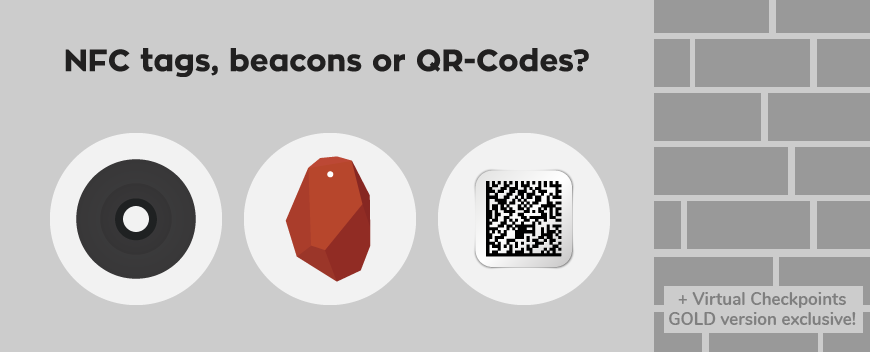But what exactly is a checkpoint?
Checkpoints are used to identify the locations that need to be visited by a guard during his patrol. They allow the security company to identify a site and to connect any incidents to it.
In this post, we are going to compare the advantages and disadvantages of 3 different types of checkpoints you can choose from: QR-codes, NFC tags and Beacons.
QR-Codes (Quick Response Codes)
A QR code is made up of black segments organized in a square grid on a white background. It can be read by a visualizing device and can be refined by error modification until the picture will be interpreted adequately.

The advantages and disadvantages of using QR-Codes as checkpoints are:
Advantages
- Minimal cost.
- Can be easily assigned to a site/location.
- You can gain larger functionality distance ranges by increasing QR-code sizes.
- You don’t have to be concerned about the interference of the surroundings.
Disadvantages
- QR-codes require balance during the scan
NFC (Near Field Communication)
NFC is a wireless technology enabling the exchange of information (text, numbers, etc) between two NFC enabled devices. NFC tags consist of tiny microchips with little aerials which can keep data to transfer to another NFC enabled device, such as a smartphone.

The advantages and disadvantages of using QR-Codes as checkpoints are:
Advantages
- Easy to read
- Minimal cost
- Quick response
- Low light functionality
- Invisible function
Disadvantages
- Higher cost than QR-codes
- Smartphones shall be NFC compatible in order to read NFC tags
- Metal materials adjacent to NFC tag may trigger disturbance
Beacons
A beacon is a small Bluetooth radio transmitter device, that uses BLE (Bluetooth Low Energy) technology to broadcast data signals on regular intervals; a Bluetooth-equipped device like a smartphone can detect those signals if within the beacon’s range.
![]()
The advantages and disadvantages of using Beacons as checkpoints are:
Advantages
- Easy to read
- Can be scanned by distance (the ones we provide can be scanned from between a few centimeters and up to 200 meters)
- Can be scanned automatically (so you can even hide them)
- They come with a Found & Lost feature, which means that every time a worker enters a specific area, an automatic found event will be sent to the manager. In the same manner, a lost event will automatically be sent every time a worker leaves a specific area
Disadvantages
- Smartphones shall be BLE compatible in order to read them
- Smartphones shall be NFC compatible in order to read NFC tags
- They have a higher cost than QR-codes and NFC tags
Virtual Checkpoints (Location Based Checkpoints)
A Virtual Checkpoint is a defined area (focal point with a range) where a guard can go through, perform a Scan and possibly some other task (just like with QR-Codes, beacons and NFC tags).

You can use Virtual Checkpoints as the rest of the checkpoint types (QR-Codes, beacons and NFC tags), i.e. you can add them to schedules, guards may attach a virtual checkpoint to a MME etc. If the guards’ device location is within the area defined by a Virtual Checkpoint, then the system automatically sends a Scan event for that Virtual checkpoint.
The advantages and disadvantages of using Virtual Checkpoints as checkpoints are:
Advantages
- No need to purchase any extra equipment, as they are location based
- Easy to read
- Can be scanned by distance
- Can be scanned automatically
- Really quick setup
- 100% flexible range
Disadvantages
- They require accurate location information to be read
Conclusions
As you can see from this comparison, each type of checkpoint has its own advantages and disadvantages. Ultimately, it is up to you to determine which one is right for your company depending on your needs.

